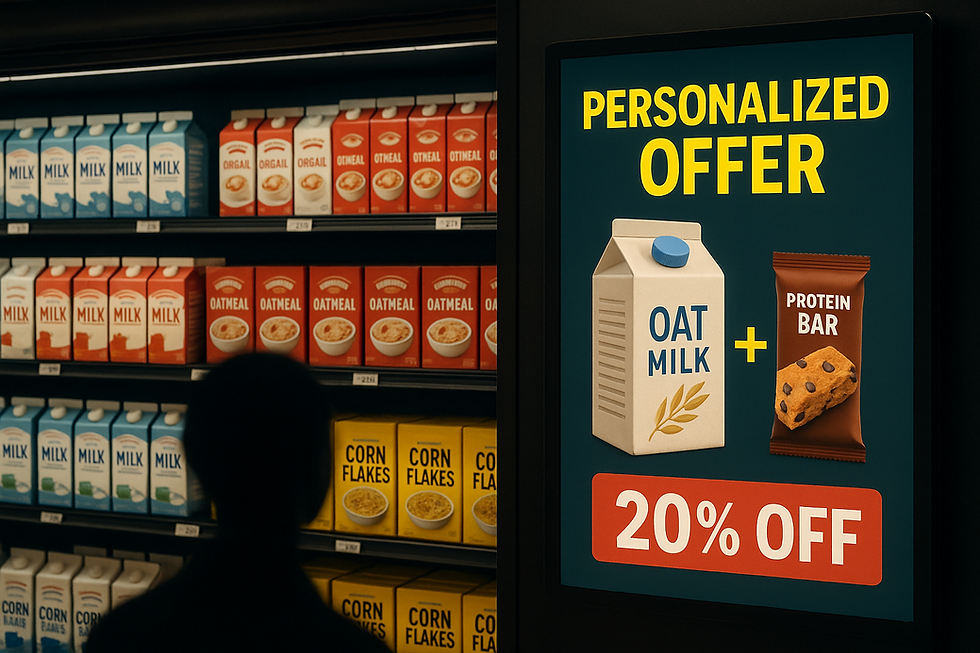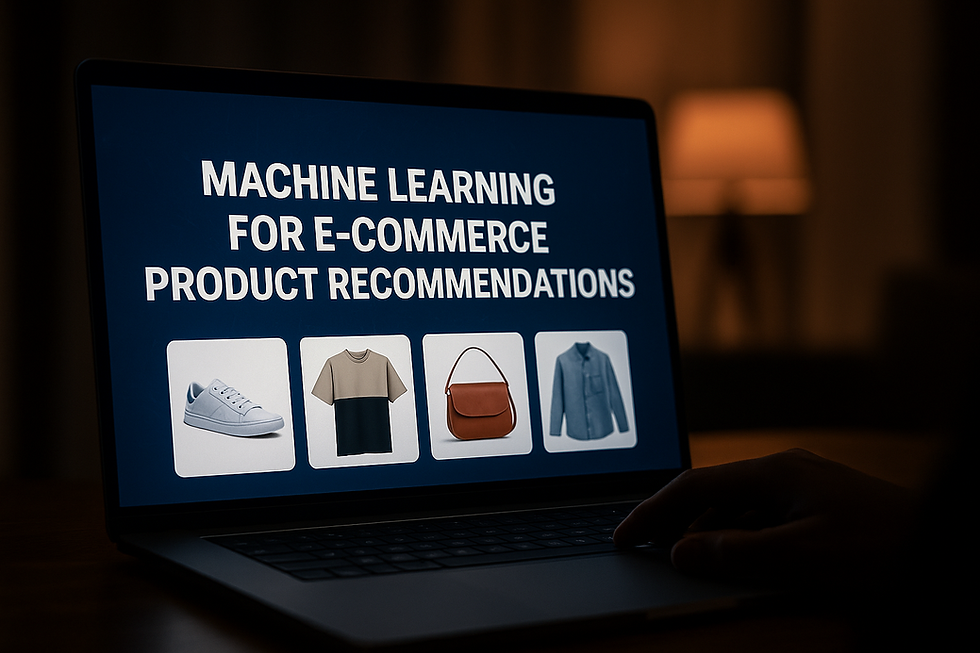Machine Learning Personalized Landing Pages: Tailoring Content to Buyer Behavior
- Muiz As-Siddeeqi

- Aug 24
- 5 min read

Machine Learning Personalized Landing Pages: Tailoring Content to Buyer Behavior
The visitor doesn’t even scroll.
They bounce.
Another wasted click. Another wasted dollar. Another potential customer gone before the page even loads properly.
Why?
Because the landing page—your digital handshake—wasn't for them. Not for their needs. Not for their intent. Not for their behavior. It was a generic billboard in a world that now demands a personal conversation.
But here’s the real shocker: As of 2024, over 74% of buyers expect a personalized experience from the very first touchpoint, according to the Salesforce State of the Connected Customer report. Yet more than 65% of landing pages are still static—same for everyone, regardless of industry, behavior, or buyer stage【Salesforce, 2024】【Instapage Report, 2023】.
This is where machine learning personalized landing pages are flipping the script—with surgical precision.
And no, we're not talking about sci-fi predictions or vague “data-driven decisions.” We’re talking about real-world, measurable, machine learning-powered personalization based on actual user behavior—what they click, how long they hover, which pages they revisit, which device they use, how fast they scroll, where they came from, and when they return.
This is the next evolution of landing pages—and the businesses embracing this are already watching bounce rates drop, engagement shoot up, and conversions climb dramatically.
So let’s peel back the curtain. We’re going deep into:
What exactly is behavior-based landing page personalization with ML?
The data streams that fuel it (100% real, documented examples)
Case studies from real companies using it successfully
Tools and algorithms powering this revolution
And how you can actually start today—even without a data science team
Bonus: Machine Learning in Sales: The Ultimate Guide to Transforming Revenue with Real-Time Intelligence
The Age of Static is Over—and the Numbers Prove It
Let’s get straight to the point. Static, one-size-fits-all landing pages are dying.
According to a 2023 report by Evergage (now part of Salesforce), companies that personalized web experiences using ML reported:
2X higher conversion rates
Over 80% improvement in engagement
Reduced bounce rates by 55%
A study by Segment (2024) found that 71% of consumers get frustrated when their online experience is impersonal. And Amazon, for example, attributes 35% of its revenue to personalized recommendations and landing experiences【McKinsey, 2023】.
That’s the gap—between businesses still stuck in the mass-messaging era and those using behavior signals + machine learning to create intelligent, real-time landing page experiences.
What Is “Buyer Behavior” Really?
Let’s get crystal clear here. Buyer behavior isn’t just “what products they clicked.” It includes:
Scroll Depth: Did they read 10% of your page or 90%?
Session Duration: Did they bounce in 4 seconds or 4 minutes?
Mouse Movement: Did they hover over a product but not click?
Source Channel: Did they come from a Facebook ad or an organic Google search?
Return Frequency: Are they a first-timer or a returning visitor?
Device Type: Are they on mobile during lunch break or on desktop at 10 PM?
These are behavioral signals.
And machine learning is what helps you make sense of them.
From Signals to Actions: How Machine Learning Converts Behavior into Tailored Pages
Let’s break it down. Step by step. No fluff.
Step 1: Data Collection (In Real-Time)
Modern tools like Segment, Heap, or Google Analytics 4 collect clickstreams, time stamps, device fingerprints, and browsing patterns. These tools track buyer behavior passively, without any friction.
Step 2: Feature Engineering
This is where raw behavior data turns into structured ML-friendly inputs. For instance:
Time on page → Converted into high/medium/low engagement
Click paths → Mapped to behavioral segments
Bounce + scroll rate → Combined to detect drop-off triggers
Tools like DataRobot and BigML make this possible without needing heavy coding.
Step 3: Model Training
Now comes the ML magic. You can train supervised models (e.g., decision trees, logistic regression) or unsupervised ones (e.g., clustering via K-means) to:
Predict likelihood to convert
Group similar user behaviors into personas
Determine which landing layout/content performs best for each persona
For example, Booking.com uses ML to test hundreds of layout variations per user group in real time【Skift Travel Tech Report, 2023】.
Step 4: Real-Time Personalization
As soon as the user visits, your ML model activates:
A “price-sensitive” visitor might see a discount pop-up
A mobile user coming from Instagram might see a simplified, visual-first layout
A high-engagement, repeat visitor might be shown testimonials or urgency messaging
Tools like Optimizely, Dynamic Yield, and Mutiny are already doing this at scale—real tools, real companies.
Real Companies Using ML-Powered Landing Pages (Documented Examples)
1. Airbnb
Airbnb uses ML to personalize landing pages by analyzing user behavior from past sessions. If a user frequently checks listings in Barcelona, Airbnb surfaces handpicked top listings in Barcelona on the next visit—even if they didn’t search for it again 【Airbnb Engineering Blog, 2023】.
2. Shopify (Plus)
In 2022, Shopify integrated dynamic content modules for merchants, powered by ML models based on user behavior and purchase intent. Merchants saw up to 18% increase in conversion rates after enabling personalized landing elements based on ML signals 【Shopify Reunite Conference, 2023】.
3. Unbounce
Unbounce’s “Smart Traffic” uses ML to automatically route each visitor to the version of a landing page that’s most likely to convert—based on past visitor behavior and profile. In a documented case study, MVMT Watches reported a 30% lift in conversions using Smart Traffic 【Unbounce Case Study Vault】.
Why It Works: The Psychology Behind Behavioral Personalization
People don’t want to “find” what they’re looking for. They want it shown to them.
Landing pages that echo a user’s intent build instant trust. Familiarity. Relevance.
Behavioral ML ensures the page feels tailored—even if it’s automated.
And let’s face it: In a world of 5-second attention spans, if your landing page doesn’t feel relevant within milliseconds, it’s already too late.
Common Personalization Features Powered by ML on Landing Pages
Here’s what top companies are tailoring using ML today:
Headline variations based on traffic source
CTA text adapted to user behavior (e.g., “Try Demo” vs “See Pricing”)
Product modules rearranged based on past interest
Color schemes adjusted based on demographic trends (yes, really)
Urgency indicators (stock running out, time-based discounts) based on dwell time
All triggered by ML models analyzing behavioral clusters or real-time scoring.
What Tools and Platforms Are Leading This?
All these tools have public documentation, real users, and case studies—not theoretical:
Tool | ML Personalization Feature | Used by |
Dynamic Yield | Predictive targeting based on behavior segments | Sephora, IKEA |
Mutiny | B2B landing personalization with LLM support | Ramp, Snowflake |
Optimizely | ML-powered experience optimization | IBM, Microsoft |
Adobe Target | Automated personalization with AI models | Verizon, Lenovo |
Unbounce Smart Traffic | Real-time traffic segmentation for landing page routing | MVMT, Later.com |
Barriers? Yes. But All Solvable.
This isn’t a fairy tale. You’ll face challenges:
Data privacy: Always anonymize data, comply with GDPR and CCPA
Cold start: Not enough data? Start small. A/B test basic versions first.
Tool overload: Start with 1-2 platforms. Don’t get distracted by tech soup.
The solution? Start simple. Even basic personalization (e.g., changing CTA based on traffic source) can yield massive gains.
How to Get Started Today (Even Without a Data Team)
You don’t need 10 engineers and a machine learning PhD to begin. Here's how small teams can win:
Use Google Optimize or Unbounce for ML-driven split testing
Track buyer behavior with Segment or Hotjar
Integrate dynamic content modules via platforms like Instapage or Elementor (for WordPress)
Train simple models using no-code platforms like Obviously AI or MonkeyLearn
Run real-time personalization experiments, and track bounce, CTR, session length, and conversions
This is not just for big brands. Startups are using these tactics to steal market share every day.
Final Thoughts: This Isn’t the Future. It’s the Urgent Present.
The difference between a visitor and a buyer is now milliseconds.
And machine learning is the only technology that can decode human behavior fast enough to respond in real time—before the tab is closed, before the scroll ends, before the bounce.
This isn't just personalization. This is relevance. This is empathy at scale. This is landing page optimization that respects your buyer's time, intention, and journey.
And for the sales teams who embrace it?
The numbers speak louder than any pitch.

$50
Product Title
Product Details goes here with the simple product description and more information can be seen by clicking the see more button. Product Details goes here with the simple product description and more information can be seen by clicking the see more button

$50
Product Title
Product Details goes here with the simple product description and more information can be seen by clicking the see more button. Product Details goes here with the simple product description and more information can be seen by clicking the see more button.

$50
Product Title
Product Details goes here with the simple product description and more information can be seen by clicking the see more button. Product Details goes here with the simple product description and more information can be seen by clicking the see more button.






Comments